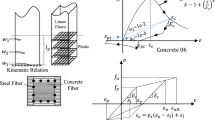Abstract
Strengthening of reinforced concrete (RC) structures with fiber-reinforced polymer (FRP) composites has become an attractive alternative for the construction industry in recent years. Unfortunately, the cost of carbon FRP or glass FRP in strengthening/repairing of RC structures is expensive. In this paper, reliability of a cheap polypropylene fiber in strengthening of RC columns and shear walls under seismic loads is investigated. For the sake of comparison, the responses of twin large-scale RC models subjected to various simulated earthquakes on a large shaking table are investigated. The columns and shear wall of the first story of one of the twin models are strengthened with 3-D woven polypropylene fiber-reinforced polymer (3-D PP-FRP). However, the other RC model is not strengthened. The results show that the PP-FRP enhances the performance of the strengthened model to sustain relatively high dynamic excitations due to significant increase in confinement, shear capacity and consequently lateral resistance of its supporting elements. This results in the postponing of structural failure. Also, even after two additional simulated earthquakes, the mode of failure of the columns is changed from the total collapse in un-strengthened model to structural damage at columns’ end connections for the strengthened one. Thus, the used material is promising in strengthening or rehabilitation of RC structures, since it is very cheap and light relative to other composite materials.


Similar content being viewed by others
References
Kosmatka J.B., Ricles J.M.: Damage detection in structures by modal vibration characterization. J. Struct. Eng. ASCE. 125(12), 1384–1392 (1999)
Abdo, M.A.-B.: Structural health monitoring using changes in dynamic characteristics. Ph.D. thesis, The University of Tokyo, Japan (2002)
Hosny, A.-H.H.; Abdelrahman, A.A.: Research progress in Egypt on strengthening concrete structures with FRP. In: The second international workshop on structural composites for infrastructure applications, Cairo (2003)
Oliveto G., Decanini L.D.: Repair and retrofit of a six storey reinforced concrete building damaged by the earthquake in south-east Sicily on the 13th December 1990. Soil Dyn. Earthq. Eng. 17, 57–71 (1990)
Toutanji, H.; Zhang, Y.: Moment–strain relationships of RC beams externally bonded with CFRP sheets. In: The second international workshop on structural composites for infrastructure applications, Cairo (2003)
Hamoush A., Ahmed S.H.: Concrete crack repair by stitches. J. Mater. Struct. 30(201), 418–423 (1997)
Naaman, A.E.: Parameters influencing the flexural and shear response of RC beams strengthened with CFRP laminates. In: The second international workshop on structural composites for infrastructure applications, Cairo (2003)
Helmy, A.I.I.: Fire protection of reinforced concrete columns retrofitted using advanced composite materials. In: 10th international colloquium on structural and geotechnical engineering, 10th ICSGE, Ain Shams University, Cairo (2003)
Tang, B.M.: FRP composite technology brings advantages to the American bridge building industry. In: The second international workshop on structural composites for infrastructure applications, Cairo (2003)
Ebied, U.; Marzouk, H.: Code verification for FRP externally reinforced concrete slabs. In: The second international workshop on structural composites for infrastructure applications, Cairo (2003)
Lopez, M.M.: Development of a finite element model of RC beams strengthened with CFRP laminates. In: The second international workshop on structural composites for infrastructure applications, Cairo (2003)
Haroun, M.A.; Mosallam, A.S.; Allam, K.H.: In-plane shear behavior of masonry walls strengthened by FRP laminates. In: The second international workshop on structural composites for infrastructure applications, Cairo (2003)
Boothby, T.E.: FRP composites in historic preservation. In: The second international workshop on structural composites for infrastructure applications, Cairo (2003)
Schnerch, D.; Stanford, K.; Lanier, B.; Rizkalla, S.: Use of high modulus carbon fiber reinforced polymers (CFRP) for strengthening steel structures. In: The second international workshop on structural composites for infrastructure applications, Cairo (2003)
Fam, A.; Mandal, S.; Schnerch, D.; Rizkalla, S.: Rectangular concrete-filled GFRP tubes as flexural and axial members. In: The second international workshop on structural composites for infrastructure applications, Cairo (2003)
Helmy, A.I.I.: Retrofitting of RC elements using locally available bi-directional polypropylene fiber from wheat flour sacs. In: The second international workshop on structural composites for infrastructure applications, Cairo (2003)
Mayorca, P.: Strengthening of unreinforced masonry structures in earthquake prone regions. Ph.D. dissertation, The University of Tokyo, Japan (2003)
Macabuag, J.; Smith, A.; Redman, T.; Bhattacharya, S.: Investigating the use of polypropylene for seismic retrofitting of masonry buildings in developing countries. In: 11th international conference on non-conventional materials and technologies (NOCMAT 2009), Bath (2009)
Fergany, E.A.: Prediction of ground motion and its application to earthquake engineering for strategic zones in north Egypt. Ph.D. thesis, Faculty of Science, Mansura University (2003)
Zarnic R., Gostic S., Crewe A., Taylor K.: Shaking table tests of 1:4 reduced-scale models of masonry infilled reinforced concrete frame buildings. Earthq. Eng. Struct. Dyn. 30, 819–834 (2001)
Chopra A.K., Clough D.P., Clough R.W.: Earthquake resistance of buildings with a soft first storey. Earthq. Eng. Struct. Dyn. 1, 347–355 (1973)
Reynolds, P.; Pavic, A.: Comparison of forced and ambient vibration measurements on a bridge. In: Proceedings of the 19th international modal analysis conference, pp. 846–851 (2001)
Schwarz, B.; Richardson, M.: Post-processing ambient and forced response bridge data to obtain modal parameters. In: Proceedings of the 19th international modal analysis conference, pp. 829–835 (2001)
Bendat J.S., Piersol A.G.: Engineering Applications of Correlation and Spectral Analysis. Wiley, New York (1993)
Saito T., Yokota H.: Evaluation of dynamic characteristics of high-rise buildings using system identification techniques. J. Wind Eng. Ind. Aerodyn. 59, 299–307 (1996)
MATLAB version 7, The Mathworks Inc. (2007)
Author information
Authors and Affiliations
Corresponding author
Rights and permissions
About this article
Cite this article
Abdo, M.AB., Hori, M. Reliability of Using 3-D Woven Polypropylene Fiber in Strengthening of a Large-Scale RC Structure Subjected to Seismic Loads. Arab J Sci Eng 37, 505–520 (2012). https://doi.org/10.1007/s13369-012-0208-3
Received:
Accepted:
Published:
Issue Date:
DOI: https://doi.org/10.1007/s13369-012-0208-3




